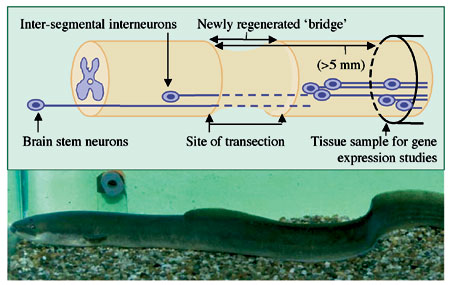| 2003 |

|
YEAR BOOK |
Trinity College Dublin
|
Spinal cord regeneration: lessons from fish
|

Professor Barry Roberts (Zoology, TCD) and colleagues have developed an experimental model for studying spontaneous spinal cord regeneration using the European eel. Co-ordinated body movements cease after complete spinal cord transection, but eventually fully recover, and this dramatic behavioural recovery is matched by an equally striking morphological regeneration. The gap of about 1 mm created by the transection is filled by a 'bridge' of tissue through which regenerating axons pass to reconnect with their targets. These axons have been shown by tracing studies to arise from cell bodies located in the brain stem, and to re-grow sequentially into the caudal spinal cord.
This study of central nervous system regeneration in the eel has recently been extended to a molecular level. Research in the Department of Zoology, lead by Dr Suzanne Borich, uses the eel model to explore the impact of removing neuronal inputs on gene expression in target neurons. The signals that guide axons to re-establish functional connections during regeneration have not been well studied. In an attempt to identify factors involved in reinnervation of the spinal cord, changes in gene expression in the target cells of the injured regenerating eel spinal cord have been studied using a technique called suppression subtractive hybridisation. A number of genes appear to be either up-regulated or turned on in target cells following transection, while several others are down-regulated or switched off. Research is ongoing to establish the identity of these genes and to determine their role in regeneration.
As there is known to be considerable evolutionary conservatism of many proteins expressed in the nervous system, it is predicted that this research on a spontaneously regenerating vertebrate will shed light on the general molecular mechanisms involved in regeneration following injury.
Contact: Dr Suzanne M. Borich, Department of Zoology, TCD; Tel:01-6081036;
E-mail: [email protected] ; Web: www.tcd.ie/Zoology/text/borich.htm